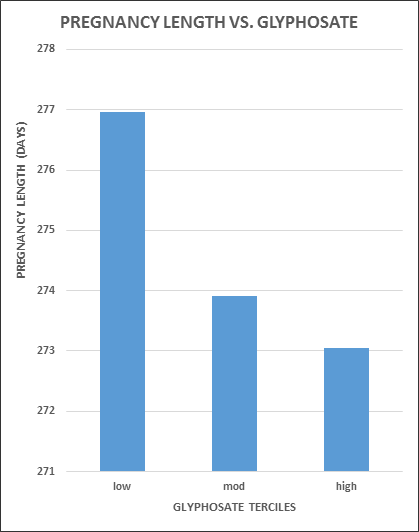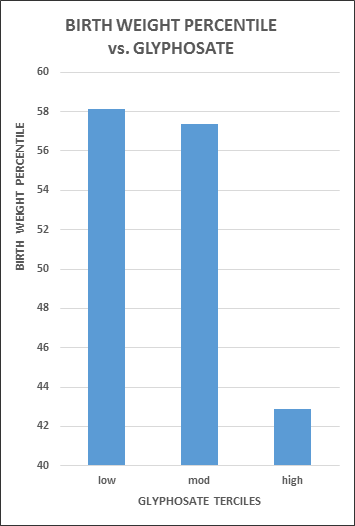Moms Exposed To Monsanto Weed Killer Means Bad Outcomes For Babies
by Carey Gillam
Concerns about the world’s most widely used herbicide are taking a new twist as researchers unveil data that indicates pervasive use of Monsanto Co.’s weed killer could be linked to pregnancy problems.
Researchers looking at exposure to the herbicide known as glyphosate, the key ingredient in Monsanto’s Roundup-branded herbicides, said they tested and tracked 69 expectant mothers and found that the presence of glyphosate levels in their bodily fluids correlated with unfavorable birth outcomes. The research is still in preliminary stages and the sample size is small, but the team is scheduled to present their findings on Thursday at a conference put on by the Children’s Environmental Health Network (CEHN) in Washington, D.C.
“This is a huge issue,” said Paul Winchester, medical director of the neonatal intensive care unit at the Franciscan St. Francis Health system and professor of clinical pediatrics at Riley Hospital for Children in Indianapolis, Indiana. He said this is the first U.S. study to demonstrate glyphosate is present in pregnant women. “Everyone should be concerned about this.”
Glyphosate is a popular agricultural pesticide, used widely in farming operations around the world. It’s commonly sprayed directly on many food crops and those used for livestock feed. But it has become the subject of hot debate over the last few years because of research that links the herbicide to types of cancer and other health ailments. Monsanto is being sued by hundreds of people who claim they or their loved ones developed non-Hodgkin lymphoma because of exposure to glyphosate-based Roundup. Monsanto, the EPA and other regulatory bodies, say evidence of carcinogenicity is lacking and the chemical is among the safest of all pesticides used in food production. But documents discovered in the course of the litigation indicate the company may have manipulated scientific research to hide evidence of harm.
The team that presented their report Wednesday included scientists who have long been skeptical of Monsanto’s products as well as medical researchers who have come to have concerns about glyphosate and other pesticides through their study of pediatric health problems.
Winchester, who led the urine sampling study, said his look at glyphosate and pregnant women is in very early stages and he and co-researchers are hoping to launch a much larger project later this year. The preliminary work detected glyphosate in the urine of 63 of 69 (91 percent) pregnant women receiving prenatal care through an Indiana obstetric practice. Researchers collected the data over two years, from 2015-2016, and found that higher glyphosate levels in women correlated with significantly shorter pregnancies and with lower adjusted birth weights.


Correlation does not prove causation. Still, the findings are worrisome because low birth weights and shortened gestation are seen as risk factors for many health and/or neurodevelopmental problems over the course of an individual’s life. Low birth weight babies are more likely to have diabetes, heart disease, high blood pressure, and to be obese, research shows.
People can be exposed to glyphosate through food and through association with farming operations that spray glyphosate on corn and soybean production fields. Both soy and corn, along with several other crops, have been genetically engineered to tolerate direct application of glyphosate. Farmers often also use glyphosate directly on wheat, oats and other non-genetically engineered crops shortly before harvest, leading to residues in grain-based food products.
Glyphosate use has climbed sharply over the last two decades with the rise of genetically engineered crops and in connection with the subsequent spread of glyphosate-resistant weeds. Dr. Charles Benbrook, one of the scheduled presenters at the CEHN conference, projects that by 2020, “more acres of cropland in the Midwest will harbor three or more glyphosate-resistant weeds than one or none.” Farmers have been trying to fight the resistant weeds with more glyphosate and other chemicals. New crops engineered to tolerate 2,4-D and dicamba herbicides mixed with glyphosate are being rolled out now. Industry data indicates herbicide use is expected to continue to climb, making it ever more critical for scientists and medical professional to get a handle on exposure levels and impacts on reproductive health, the team said in their presentation.
Winchester has been conducting research into pesticide exposures and impacts on pregnant women for many years, including in-depth work on atrazine, another herbicide popular with farmers. He said he was surprised to see such a high percentage of women tested showing glyphosate in their urine. He said much more research on glyphosate impacts is needed, and more data is needed on levels of exposure through food. He was sharply critical of the U.S. government, which routinely skips testing for glyphosate residues in food even though regulatory agencies test thousands of food products each year for residues of other types of pesticides, including atrazine.
He and the other researchers are calling on the Centers for Disease Control to include glyphosate and its primary metabolite, aminomethylphosphonic acid (AMPA) in biomonitoring work it does to track levels of pesticides and other chemicals in urine and blood.
“Is this level of exposure safe or not? We’ve been told it is, but exposures haven’t been measured,” Winchester said. “It’s mind-boggling.”


